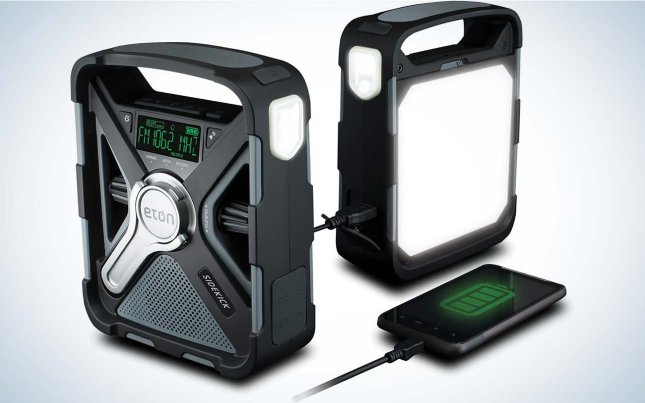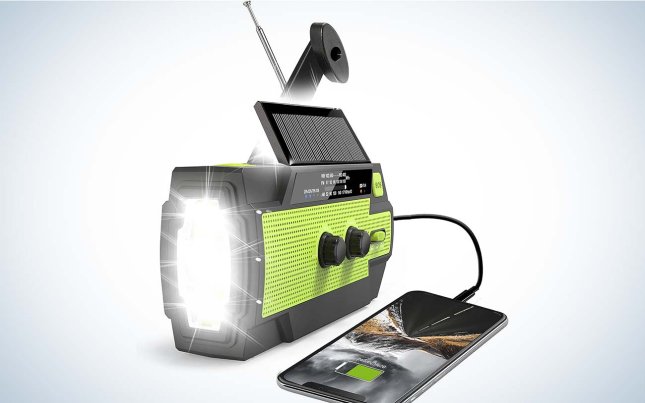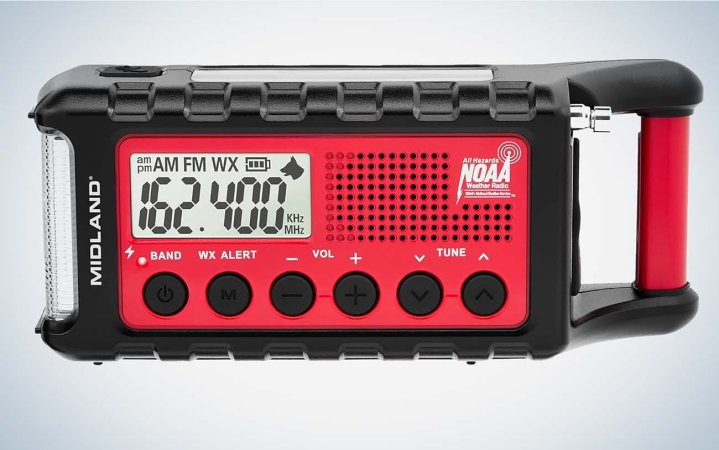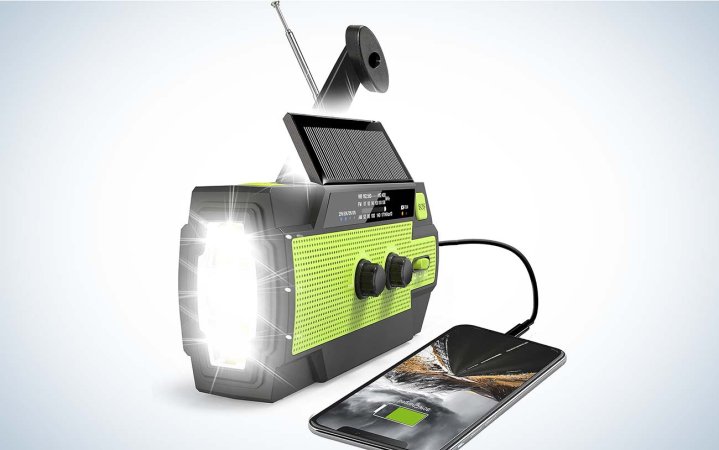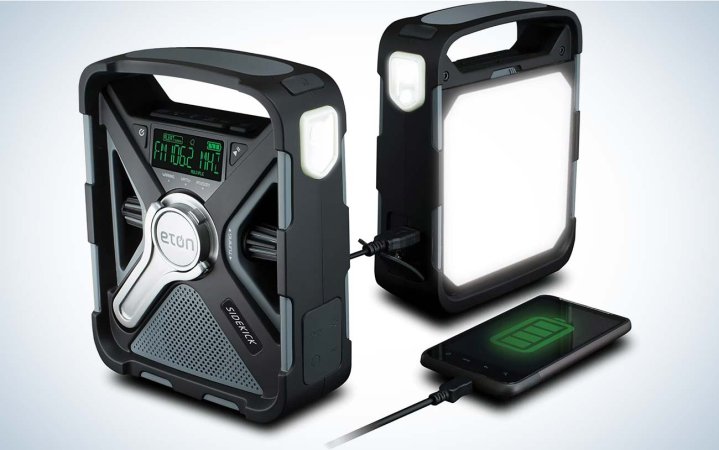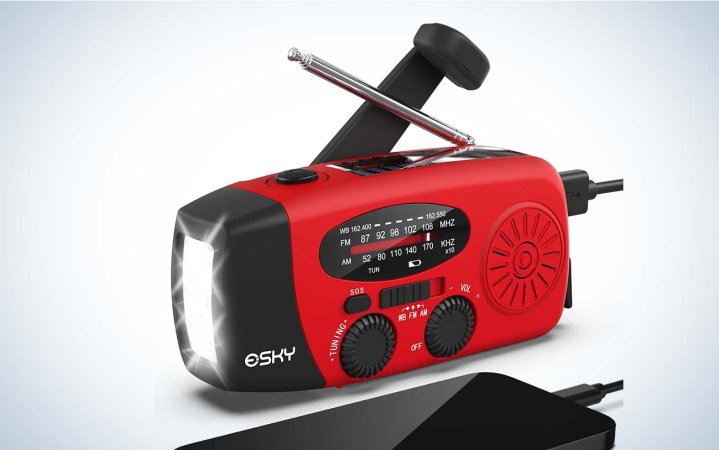We may earn revenue from the products available on this page and participate in affiliate programs. Learn more ›
When disaster strikes, staying informed can be the difference between safety and danger, and an emergency radio helps you span that divide. Whether deep in the wilderness or prepping for a natural disaster at home, these radios are essential survival gear. With a range of options available, many models come packed with useful features that can enhance your everyday life, even when things are going smoothly. They can keep devices powered and you empowered. Designed to be durable and ready for anything, these receivers—like our best overall pick, the Midland 310 ER310—are built tough for when the going gets toughest. The best emergency radios are reliable even when the power isn’t.
- Best overall: Midland 310 ER310
- Best value: Midland ER210
- Best budget: Runningsnail Emergency Crank Radio
- Best splurge: Eton Sidekick
- Best design: Kaito KA500
How we chose the best emergency radios
Here at Popular Science, we know that having the right tool to depend on when the moment calls is essential. That’s why we scoured the internet, poring over dozens of professional reviews and scores of consumer reviews to get a sense of what really matters when picking the best emergency radios. From expert opinions to firsthand user experiences, we aggregated insights, hunting for those specific features and build-quality markers that set the great ones apart from the rest, including durability, reliability, and ease of use. After narrowing down the options, we leaned on our team’s outdoor experience to zero in on our favorites.
The best emergency radios: Reviews & Recommendations
The following radios have been selected for their usefulness and reliability in stressful situations. They won’t have the sound quality of the best Bluetooth speakers, but when you need a radio that can get you through a common thunderstorm or intense weather events and require something that can be an invaluable tool in the backcountry, you’ll find something on this list. Next to a fully charged solar generator, an emergency radio is our top recommendation for gear to keep around if you’re located somewhere historically impacted by hurricanes, extreme snowfall, earthquakes, and other such events.
Best overall: Midland 310 ER310
Specs
- Band Reception: AM/FM, NOAA Weather
- Power source: Solar, hand crank, rechargeable 2,600 mAh battery, AA batteries
- Weight: 1 pound 7 oz
- Dimensions: 8.0” x 3.4” x 2.4
Pros
- Multiple alerts for rescuers to find you
- Bright built-in flashlight
Cons
- Relatively pricey
- Not as compact or light as other options
Midland is a stalwart in the world of weather radios, and the Midland ER310 is built for reliability with a rugged design that can withstand a beating and still give you great versatility.
This radio is designed with ease of use in mind. The backlit display screen makes navigating settings simple, even in low-light situations. It’s powered by a 2,600 mAh rechargeable battery; but it can also be juiced with the attached hand crank, a solar array, or AA batteries in a pinch. The crank works well, giving you over 10 minutes of radio usage for just one minute of cranking. This battery-powered radio has enough juice to allow you to charge your devices, like a phone, via USB as well.
The built-in flashlight is impressively bright with a bright and low setting. If you are in an emergency, the built-in SOS flashlight beacon sends out a Morse code signal for emergency assistance, adding another protection layer when needed. It also has an ultrasonic whistle, which can send out a signal to rescuers and search dogs if you find yourself lost in the wilderness.
The ER310 features NOAA Weather Radio with Alert, sounding loud alarms when extreme weather alerts come through, ensuring you’re never caught off-guard. With loud, visible notifications and reliable reception, the ER310 keeps you informed and ready for any situation.
Best value: Midland ER210
Specs
- Band Reception: AM/FM, NOAA Weather
- Power source: Solar, hand crank, 2,200 mAh battery
- Weight: 1 pound
- Dimensions: 7.5” x 5.25” x 2”
Pros
- Convenient carrying handle
- Compact size
- Handle charging gives you a great amount of usage time
Cons
- Crank is smaller, so less to hold onto
- Fewer bells and whistles
The Midland ER210 is slightly smaller in both size and battery life compared to the ER310, making it a sleeker, more portable option without sacrificing the essentials. It does, however, lose a few features, including being able to use disposable backup batteries.
The ER210 comes equipped with a bright flashlight and a loud alarm that sounds when NOAA weather alerts come through. The backlit LED screen is easy to read, even in the dark, and switching between bands is effortless thanks to straightforward controls. While it doesn’t feature the dog whistle or the option to use disposable batteries like the ER310, the ER210 still offers impressive charging speed for such a small solar panel and similar efficient use of the crank to charge the rechargeable battery.
The slimmer and more affordable option is great for those who need a more simple emergency radio without paying for the additional bells and whistles.
Best budget: Runningsnail Emergency Crank Radio
Specs
- Band reception: AM/FM, NOAA weather
- Power source: Hand crank, solar, rechargeable 4,000 mAh battery, AAA batteries
- Weight: 11 oz
- Dimensions: 6.2” x 2.1” x 2.9”
Pros
- Affordable
- Large battery, especially for weight
Cons
- Cheaper quality on build
- Analog rather than digital tuner
The Runningsnail Emergency Crank Radio offers many of the same essential features found in higher-end models but at a much lower price. While the finish and build quality may not be top-tier, it gets the job done without breaking the bank. The analog radio tuner can be trickier to fine-tune compared to digital options, but it’s a small trade-off for affordability.
Despite its price point, the Runningsnail comes equipped with an SOS alarm and flashing red light for emergencies. However, unlike more expensive radios, the alarm doesn’t trigger automatically with weather alerts—you’ll need to turn the radio on manually. The 3-mode LED flashlight (spot, flood, and combo) is a standout feature capable of effectively lighting up any dark situation.
The radio’s USB port is a handy addition, allowing you to charge other devices with ease—perfect given its battery capacity. The solar panel, however, falls short in performance. You’ll get better results by relying on the hand crank or USB charging to power the radio. While it’s not perfect, the Runningsnail delivers a solid set of features for a fraction of the cost.
Best splurge: Eton Sidekick
Specs
- Band reception: AM/FM, NOAA weather
- Power source: Hand crank, solar, rechargeable 2,600 mAh battery
- Weight: 1 lb. 6 oz
- Dimensions: 7.1″ x 5.8″ x 2.3″
Pros
- Bluetooth and aux cord for playing own music
- Durable design with easy carry handle
- Emergency or camping use
Cons
- High cost for luxury features
- The flashlight isn’t the brightest
The Eton Sidekick is a versatile emergency radio that offers more than just weather alerts. With Bluetooth and aux cord options, you can play your own music, making it a great addition for both casual settings and emergencies. It’s packed with features like the ability to pick up standard NOAA weather alerts, plus the advanced S.A.M.E. (Specific Area Message Encoding) system, which allows you to program up to 25 county codes for hyper-local weather updates. This ensures you receive real-time alerts for the areas that matter most.
Equipped with a 2,600 mAh battery and an easy-to-turn crank handle, the Sidekick is designed for reliable power even when off the grid. The 5V USB output adds convenience by allowing you to charge your other devices, a critical feature during extended power outages, even at home. Its digital tuner and display, combined with an emergency beacon, keep things simple and functional.
The Sidekick also boasts a flashlight and a large ambient light with a dimmer for when you need softer illumination. While the solar panel isn’t the most effective, the array of other features makes this radio the best premium pick whether you’re at home, on a trail, or facing an emergency.
Best design: Kaito KA500
Specs
- Band reception: AM/FM, NOAA weather, and shortwave
- Power source: Hand crank, solar, rechargeable 600 mAh battery, AA batteries, optional AC wall adapter
- Weight: 1 lb., 6.4 oz.
- Dimensions: 8.8” x 5.8” x 2.8”
Pros
- Extremely durable rubber and plastic shell
- Shortwave radio for global news
Cons
- Small battery
- Heavy and bulky design is not great for portability
The Kaito KA500 is built for those who prioritize durability in an emergency radio. Its rugged construction ensures it can handle tough conditions, but this durability comes at the cost of extra weight, making it one of the heavier options out there. However, for those setting up a more permanent station, like in a cabin, it offers multiple charging options, including an AC wall plug for fast and reliable power.
The KA500 comes preprogrammed with NOAA weather channels and also has the capability to receive shortwave radio broadcasts, giving you access to global news when you’re off the grid. Its long telescoping antenna and LED signal strength indicator help ensure you’re always tuned in to the right frequency. It also features an “Alert” mode, which automatically turns the radio on when it receives emergency alerts from NOAA.
While the battery isn’t quite large enough to reliably charge other devices, the radio itself is packed with additional features like a reading lamp, flashlight, and a red blinking emergency light. Despite its size and heft, the Kaito KA500 is one of the best options for those prioritizing ruggedness and reliability in emergencies.
Also worth considering: Esky Portable Emergency Weather Hand-Crank Radio
Specs
- Band reception: AM/FM, NOAA Weather
- Power source: Hand crank, solar, 2,000 mAh rechargeable battery
- Weight: 7.5 oz
- Dimensions: 5.3” x 2.5” x 2”
Pros
- Great size for easy storage in car
- Lightweight for carrying
Cons
- Battery is not great for charging other devices
- Limited additional functionality
- The telescoping antenna can be a bit fragile
The Esky Portable Emergency Weather Hand-Crank Radio is a solid choice for commuters and those looking to keep an emergency device in their car. It doesn’t come with a lot of extras, but it covers the essentials. Equipped with both standard and micro USB ports, it allows for charging other devices.
Its low-profile knobs for power, volume, and tuning are designed to avoid snagging on other items when you’re pulling the radio out of a pocket or bag—perfect for when you need it on the go. While the analog display isn’t the easiest to read, and finding a specific frequency can be a bit tricky, it still provides a reliable connection to AM/FM and NOAA weather stations. For those looking for a no-frills, compact emergency radio, the Esky is a dependable companion for staying connected in tough situations.
Things to consider when buying an emergency radio
From simple radio receivers to all-in-one survival and rescue communication devices, there are many options to consider when buying an emergency radio. Considering where you’ll be, how long you’ll be there, and the emergencies you expect to face will help you pick the right emergency radio for you.
How will you use it?
Consider whether the radio is meant strictly for emergencies or if you’ll also use it for activities like camping or at home. Are you looking for a standalone radio, or would you prefer an all-in-one solution with features like a flashlight, ambient light, or even a phone charger? Think about your other survival gear—do you need a rugged, durable radio that can withstand rough conditions, or would a lighter, more delicate model work if you plan to handle it carefully? Maybe you’ve already got a headlamp; maybe you don’t.
Where will you store or carry it?
The way you plan to use your emergency radio will greatly influence the type you need. If you’re carrying it with you, you’ll want something compact and lightweight. On the other hand, if it’s going to be a more permanent fixture in your home, cabin, or car, you may not mind a larger, heavier model with more features. Consider where the radio will be stored or how you’ll transport it—this will help determine the size and weight that make sense for your needs.
By thinking about your storage and portability preferences, you can find a radio that fits seamlessly into your routine or emergency plans.
What emergency features do you need?
Listening to the radio for emergency updates is essential, but some radios offer additional features that could be lifesaving in critical situations. Think about how and where you’ll use this radio. If it’s staying at home, a simple model may be enough. However, if you anticipate being in a situation where rescue might be necessary, consider radios with features like flashing SOS lights or other signaling methods to alert rescuers.
Additionally, consider whether you’ll be actively monitoring the radio or potentially facing an extended emergency situation. Some radios have automatic alert features that turn on or notify you when new emergency broadcasts are released, ensuring you stay informed even if you’re not actively tuning in.
FAQs
While you may be able to get emergency updates in your area via your local AM and FM radio stations, your best bet will be to check the national weather radio bands hosted by the National Oceanic and Atmospheric Administration (NOAA) when disaster strikes or is imminent. There are seven NOAA frequencies and most emergency weather radios will allow you to tune into the strongest nearby.
While a radio will need electricity, there are many options that don’t need you to plug them into the wall. Many emergency radios feature a hand crank that allows you to charge an internal battery. The hand-cranking motion gives you enough power to supply the relatively low amount of electricity needed to use a radio. Of course, there are many other power options, including rechargeable internal batteries, solar power, disposable batteries, and wall power.
While hand crank radios may have another power source you can use to keep you from having to constantly crank the radio (like a larger USB rechargeable internal battery or solar panel) most commonly they will have at least a small internal battery that will store electricity and allow you to listen for an extended period of time after cranking, without any other power source.
Final thoughts on the best emergency radios
- Best overall: Midland 310 ER310
- Best value: Midland ER210
- Best budget: Runningsnail Emergency Crank Radio
- Best splurge: Eton Sidekick
- Best design: Kaito KA500
Packed alongside a portable power bank, an emergency radio can offer you invaluable performance in case of an emergency. Whether you’re looking for an option-packed hard worker or a sleeker package that’s easy on your pack and pocketbook, we’ve listed options above that are durable, versatile, and even affordable. Whether you’re looking to get radio signals from around the world or just get help when stranded, an emergency radio is essential at home, on the road, on a camping trip, or anywhere else you should expect the unexpected.

